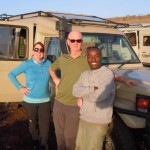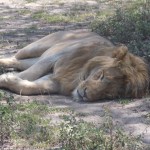
Mount Kilimanjaro is the highest mountain in Africa rising 5,895m above sea level in the Kilimanjaro National Park, Tanzania. It is one of the acclaimed ‘Seven Summits of the World’ and a tourist haven for adventurous travellers.
It rises abruptly from the open planes to form the snow-capped peaks of Kibo and Mawenzi, which are frequently fringed by clouds. Kilimanjaro, with its three volcanic cones, Kibo, Mawenzi, and Shira, is a dormant volcanic mountain that developed hundreds of thousands of years ago.
The strong smell of sulphur fumes is sometimes emitted from inside the crater and fumaroles still escape from the inner Ash Pit. The origin of the name “Kilimanjaro” is shrouded in mystery. In Kiswahili, the word kilima means “small hill”, while –njaro means “greatness.” The last word also means “caravan” in Kichagga, the language of the skilled people who settled around the lower slopes.
According to ancient myths, Njaro is also the name of a fearful demon that was believed to have been living on the summit. Last but not least, for the Waswahili people, drivers of the caravans for centuries, the word Kilimanjaro meant “landmark.” Kilimanjaro, by any name, is a metaphor for the compelling beauty of East Africa and the crown of Tanzania.
When you see it, you understand why. Not only is this the highest peak on the African continent; but it is also the tallest free-standing mountain in the world, rising in breathtaking isolation from the surrounding coastal scrubland around 900m to an imperious 5895m on the summit of Uhuru Peak/Kibo Peak. Kilimanjaro is one of the world’s most accessible high summits, a beacon for visitors from around the world.

Different routes can be followed on Kilimanjaro in an attempt to reach the roof of Africa’s great mountain. Most climbers reach the Crater rim with little more than a pair of trekking poles, proper clothing, and determination. And those who reach Uhuru Point, the actual summit of Kilimanjaro will have earned their climbing certificates and cherished memories to last a lifetime.
But there is so much more to Kilimanjaro than her summit. The ascent of the slopes is a virtual climatic world tour, from the tropics to the Arctic. Even before you cross the national park boundary at about 2700m, the cultivated foot slopes give way to lush montane forest, inhabited by elusive elephant, leopard, buffalo, the endangered Abbot’s duiker, and other small antelope and primates.
The surrounding rainforest ensures the fertility of the lush, lower-lying Shamba country, where the Chagga people cultivate their coffee, maize, and bananas. Higher still lays the moorland zone, where a cover of giant heather is studded with otherworldly giant lobelias. Above 4,000m, a surreal alpine desert supports little life other than a few hardy mosses and lichen. Then, finally, the last inherent vegetation gives way to a winter wonderland of ice and snow and the magnificent beauty of the roof of the African continent.
The eight-day trekking Northern Circuit – Lemosho – Route itinerary gives the maximum possible acclimatisation and flexibility to enjoy the magnificent mountain scenery that extends from the volcanic summit to the vast African plains.
The remote Lemosho Route I guide my clients on is a breathtaking option for trekkers eager to explore less-stamped trails through diverse mountain conditions. We trek through forest and moorland to the caldera of the Shira volcano and explore the captivating rock formations on the Shira Plateau before traversing beneath the southern ice fields of Kilimanjaro.
We enjoy spectacular early morning views of Kibo as we follow the main route to the summit of Uhuru Peak (5,895m) on the Crater rim. In climbing the magnificent mountain you will pass from a tropical climate to an arctic climate in a few thrilling days to proudly stand on the roof of Africa!
Itinerary
Day 1: Arrive at Kilimanjaro National Airport (JRO), Tanzania – Under The Shade Safari Lodge, Arusha (1,387m)
Drive time: 1 hour
Meal Plan: Dinner at Under The Shade Safari Lodge
Day 2: Under The Shade Safari Lodge, Arusha (1,387m) – African time zone acclimatisation day in Arusha. Climb orientation with Cherie & African guides. Clothing & equipment check.
Meal Plan: Breakfast and Dinner at Under The Shade Safari Lodge,
Day 3: Under The Shade Safari Lodge, (1,387m) – Londorossi Park Gate (2,250m) – Mti Mkubwa Camp (2,750m)
Meal Plan: Breakfast/Lunch/Dinner
Drive time: 3-4 hours driving from Arusha
Walking time: 4-5 hours
Day 4: Mti Mkubwa (2,750m) – Shira 1 Camp (3,550m)
Meal Plan: Breakfast/Lunch/Dinner
Walking time: 6-8 hours
Day 5: Shira 1 Camp (3,550m) – Shira 2 Camp (3,840m)
Meal Plan: Breakfast/Lunch/Dinner
Walking time: 4-5 hours
Day 6: Shira 2 Camp (3,840m) – Barranco Camp (3,950m)
Meal Plan: Breakfast/Lunch/Dinner
Walking time: 6-8 hours
Day 7: Barranco Camp (3,950m) – Karanga Valley Camp (4,000m)
Meal Plan: Breakfast/Lunch/Dinner
Walking time: 3-5 hours
Day 8: Karanga Valley Camp (4,000m) – Barafu Camp (4,600m)
Meal Plan: Breakfast/Lunch/Dinner
Walking time: 3-6 hours
Day 9: Barafu Camp (4,600m) – Summit Uhuru Peak (5,895m) – Millennium Camp (3,900m)
Meal Plan: Breakfast/Lunch/Dinner
Walking time: 6 -7 hours to Crater rim of Stella Point, 1 hour to summit, 3- 4 hours to Barafu, 3-4 hours to Millennium Camp (3,900m)
Day 10: Millennium Camp (3,900m) – Mweka Park Gate (1,650m) – Under The Shade Safari Lodge, Arusha (1,387m)
Meal Plan: Breakfast: Mweka Camp/Lunch: Mweka gate/Dinner: Under The Shade Safari Lodge
Walking time: 3-4 hours
Drive time: 2-3 hours
Day 11: Under The Shade Safari Lodge, Arusha – Kilimanjaro National Airport, Tanzania or Safari Extension – Marera Valley Lodge. Karatu
Meal Plan: Breakfast/Lunch: Under The Shade Safari Lodge/Dinner: Marera Valley Lodge, Karatu
Drive time: 2-3 hours
Day 12: Safari – Marera Valley Lodge, Karatu, – Ngorongoro Crater – Marera Valley Lodge, Karatu
Meal Plan: Breakfast at Marera Valley Lodge/Picnic Lunch/Dinner at Marera Valley Lodge
Drive time: Full-day Safari tour
Day 13: Safari – Marera Valley Lodge, Karatu, Safari – Tarangire National Park – Kibo Palace Hotel, Arusha.
Meal Plan: Breakfast at Marera Valley Lodge, Karatu/Picnic Lunch/Dinner at Kibo Palace Hotel, Arusha.
Drive time: Full-day Safari tour
Day 14: Departure – Kibo Palace Hotel, Arusha. Depart to Kilimanjaro National Airport, Tanzania
Meal Plan: Breakfast at Kibo Palace Hotel, Arusha
Drive time: 0.5 hours
End of the expedition …. KARIBU TANZANIA
* Itinerary subject to change
* Minimum number of people for guaranteed expedition departure – 6 people
* Single room/tent supplement available at an additional cost of $600 USD
* Detailed trek itinerary and information (clothing & equipment list; medical information; FAQ’s) issued upon booking
Trek Inclusions:
- Arrival/Departure transfers on both domestic and international flights
- Professional African mountain guides
- Experienced camping chef, kitchen assistants and porters for the trek
- Camping and catering equipment
- Meet and Greet
- Trip briefing
- AMREF: Emergency Medical Evacuation
- Quality Hotel accommodation in Arusha before and after the trek (twin share)
- Three unlimited meals per day during the trek
- Breakfast and dinner in Arusha before and after the trek
- All Park fees (approx. $1000 USD)
- All government taxes for indicated services
- Rescue fee on the trek
- 1.5 litre bottled water on the first day of the trek and 4-5L boiled water each day during the trek
- Transfer to Londorossi Gate and pick up from Mweka Gates
- Forest fees at Londorossi Gate
- Transfers from and to Kilimanjaro International Airport (JRO)
- Pre-trek training advice prescribed by Cherie including mentoring and support from the moment you commit to the expedition
- Professional & experienced African trekking co-guide & assistant guides well trained in Wilderness First Aid
- Porters are to carry all personal gear and group camping equipment
- Comprehensive First Aid Kit
- Portable Oxygen Cylinder
- Trip Certificate
Trek Exclusions:
- Internal and International flights
- International airport departure taxes
- Tips to African guides & porters
- Drinks (other than boiled water during the trek)
- Alcoholic and carbonated drinks at Under The Shade Safari Lodge, Arusha
- Lunches at Under The Shade Safari Lodge Arusha – Day 1, 2, 10.
- Single room/tent supplement
- Visa and travel insurance
- Vaccinations and malaria medication
- Any add-on tours or activities not mentioned in the program
- All personal clothing for the climb
- Sleeping bag
- Flat sleeping mattress
- Expenses of personal nature (laundry, phone calls)
Safari Tour
I have arranged a fantastic Great Northern Highlights Safari that will take place immediately after the Kilimanjaro Climb.
This captivating tour features thrilling game viewing in the Tarangire and South Serengeti National Parks and the Ngorongoro Crater.
Full safari itinerary available with detailed expedition notes upon booking.
Thank you.
Safari Inclusions:
- AMREF: Emergency Medical Evacuation
- Full Board Lodge accommodation on Safari
- Three meals per day during Safari
- Professional English Speaking Driver/Guide
- Game drives in 4WD with pop-up roof for proper game viewing & photographing
- All Park fees
- All government taxes for indicated services
- Crater fees
- 5 litre bottled water per person per day during safari
- Transfers to Airport
Safari Exclusions:
- International flights
- International airport departure taxes
- Tips and Gratitude to the guide (Tipping is common in Tanzania)
- Drinks
- Laundry
- Visas and travel insurance
- Vaccinations and malaria medication
- Any add-on tours or activities not mentioned in the program
- Balloon Safari in Serengeti (USD $546 per person)
- Olduvai Museum fee (USD $36 per person)

















